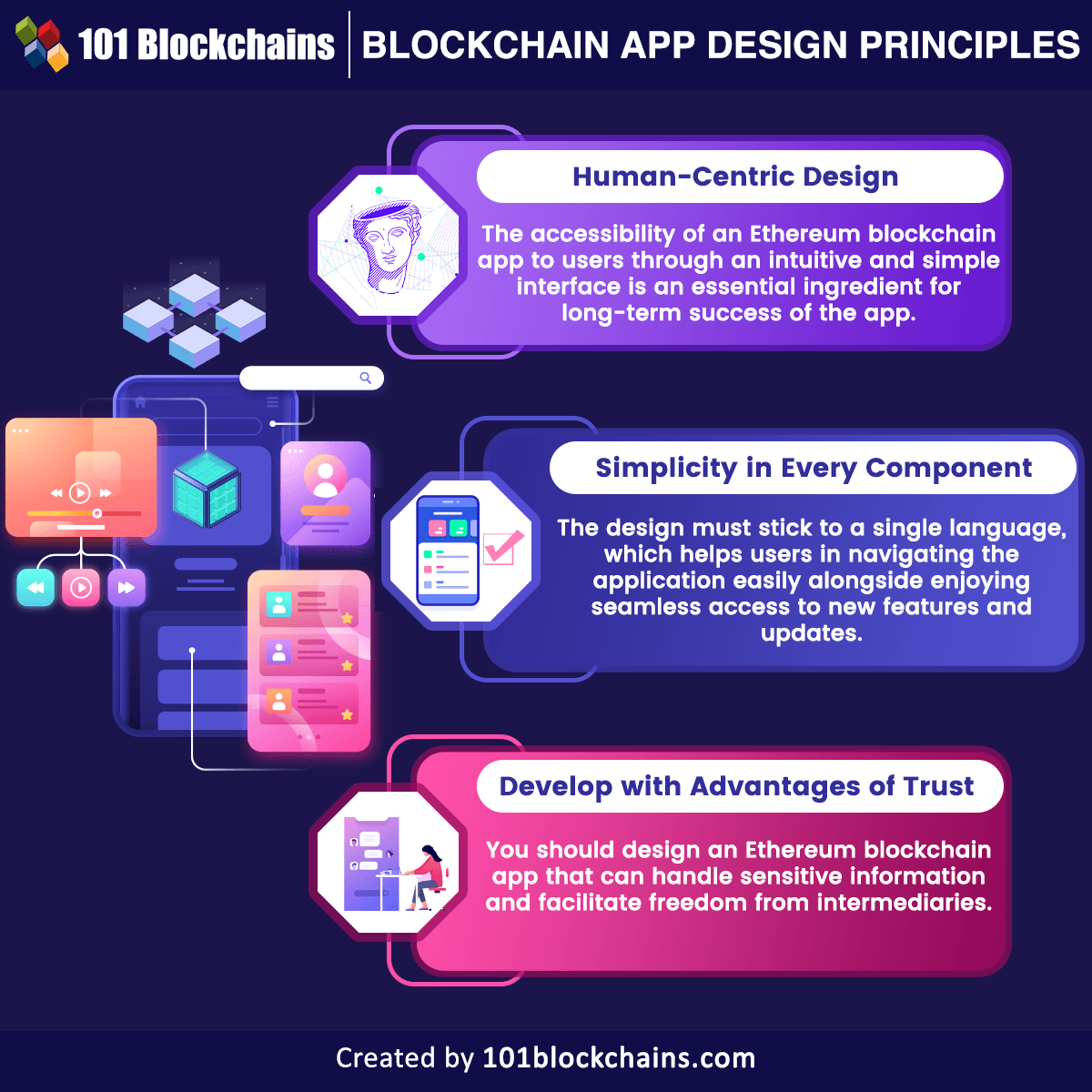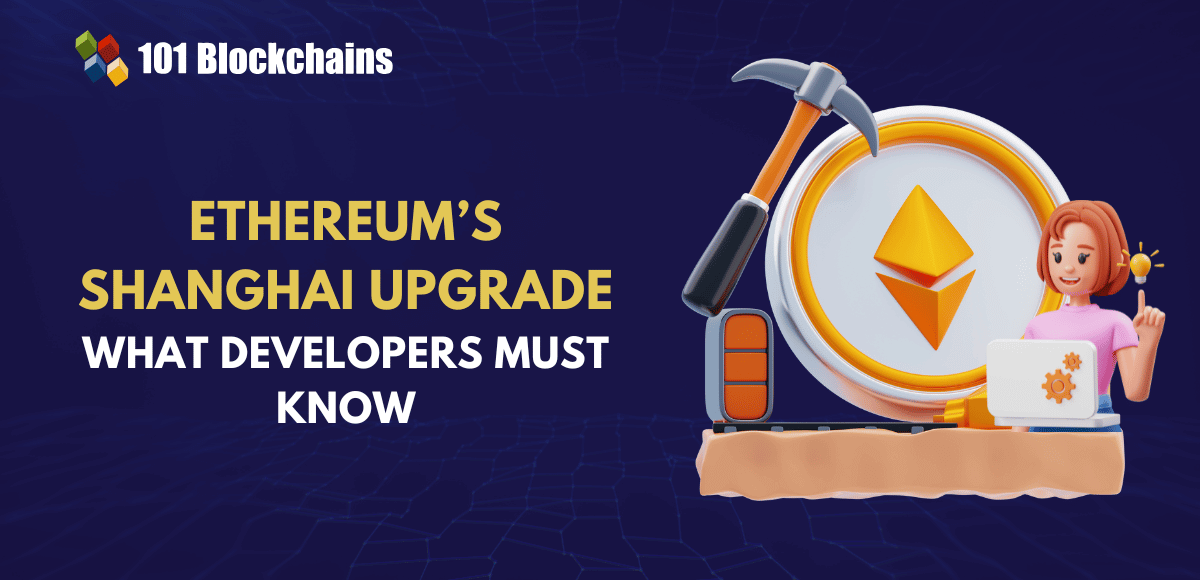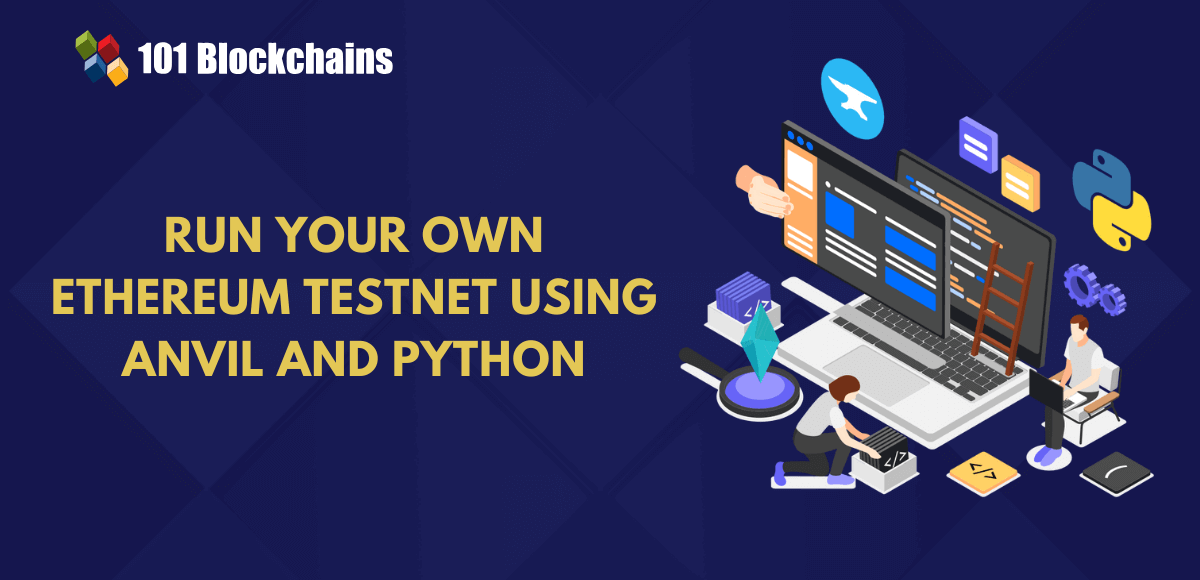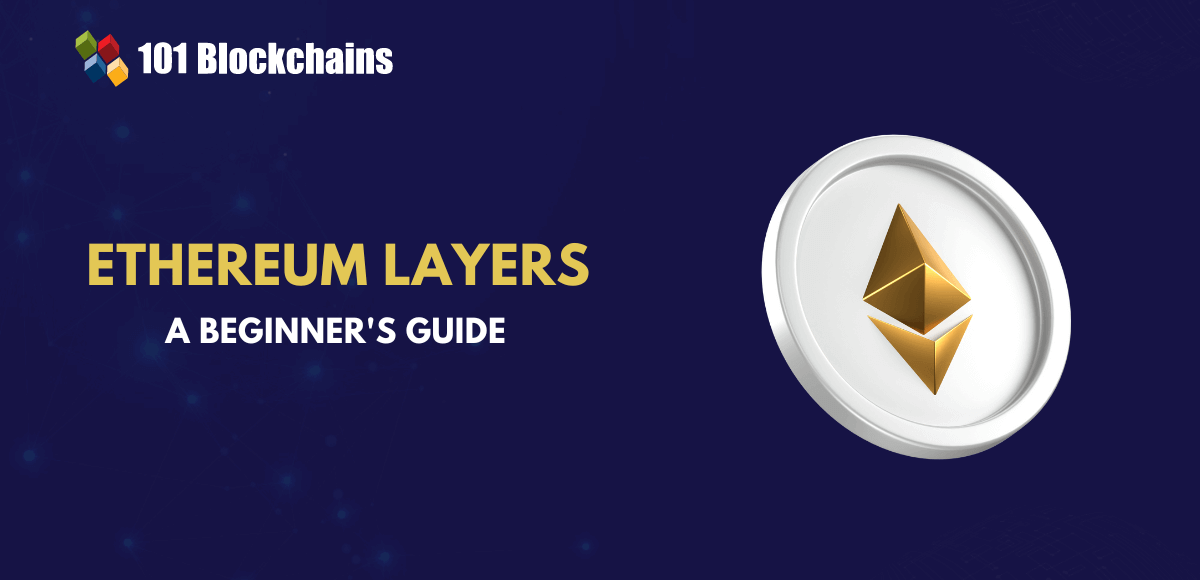Learn how blockchain truly works, master key definitions, and uncover what makes smart contracts so "smart." Dive into the fundamentals, gain valuable insights, and start your blockchain journey today!

- Ethereum
James Howell
- on June 23, 2023
How to Design an Ethereum Blockchain Application?
Blockchain is still a mystery for many people worldwide, owing to the ambiguous perceptions regarding its identity. The thought of blockchain draws indications towards complicated cryptography mechanisms, cryptocurrencies and lines of code. If you want to create apps on Ethereum, then you can capitalize on the prospects of developing innovative solutions for the future. Decentralized apps have become one of the most value-centric solutions in the tech landscape right now. As the number of decentralized applications on Ethereum grows beyond 2700 dApps, it is important to learn the best practices for creating blockchain apps. The Ethereum blockchain processes around 1 million transactions daily, which suggests that it is still a top choice for blockchain application development. The following post helps you learn about the fundamental principles of Ethereum blockchain app design and important design patterns for smart contracts.
Ethereum has captured around 63% of the DeFi market share, and almost every new NFT collection trending on Twitter uses the Ethereum blockchain. You can learn about the fundamental principles of designing an Ethereum blockchain app and create your own solution.
Excited to build your skill in Ethereum development by leveraging the ethers.js library? Enroll Now in Ethers.Js Blockchain Developer Course!
What Is The First Thing You Need to Design Ethereum App?
The first thing required for designing an Ethereum blockchain app is to learn about the fundamentals of blockchain. Before you find out the best practices for Ethereum app development, you should know how blockchain delivers a new way of documenting transactions. Blockchain is a distributed ledger that records every transaction in a cryptographic manner across multiple nodes on a network. Every block of data stored on the blockchain is immutable and cannot be altered once you have deployed it on the blockchain.
Blockchain offers the advantage of immutability, security and transparency. Ethereum offers the value of smart contract programming to the blockchain ecosystem, which helps in churning out thousands of dApps every year. Many businesses are interested in building an Ethereum blockchain app for capitalizing on the value of decentralization. Ethereum smart contracts provide the flexibility for creating code according to your desired use cases. Smart contracts help facilitate automation of transactions, which can ensure efficiency in dApps. You can notice the importance of smart contracts in designing an Ethereum dApp.
The answer to “How to make an Ethereum program?” would refer to the design of a general blockchain app. Do you know how a blockchain app works? You can find the answer through a review of the ways in which it relates to the working of a normal web application. Generally, you would access a web application through a web page on a browser of your choice. The code on the website is present on a central web server which communicates with the backend, which in turn contacts the database for retrieving data.
In the case of blockchain applications, the browser interacts directly with the blockchain, which serves as the backend. The blockchain stores all the essential data and code for the decentralized Ethereum app and delivers advantages of efficient transaction processing.
Want to learn the basic and advanced concepts of Ethereum? Enroll in our Ethereum Development Fundamentals Course right away!
Fundamental Design Principles of Blockchain Apps
The most crucial requirement for developing Ethereum apps focuses on learning about the basic blockchain design principles. The demand for an Ethereum blockchain app tutorial has been growing as the adoption of DeFi continues to rise. Whether it is Web3 or fintech, Ethereum apps are everywhere, and compliance with the basic design principles guarantees their efficiency.
The design of an Ethereum blockchain app would depend on different factors such as the target audience, your knowledge of blockchain and the potential future of blockchain. The fundamental principles of blockchain design help in ensuring that your Ethereum blockchain app has the essential traits for success. Here is an outline of the crucial basic design principles for blockchain applications.
Build your identity as a certified blockchain expert with 101 Blockchains’ Blockchain Certifications designed to provide enhanced career prospects.

-
Human-Centric Design
One of the foremost highlights of Ethereum blockchain apps is the ability to empower users. The basics of Ethereum blockchain app design revolve around ensuring the best possible rates of adoption. Therefore, it is important to design the application in such a way that users can understand it. The accessibility of an Ethereum blockchain app to users through an intuitive and simple interface is an essential ingredient for long-term success of the app.
-
Simplicity in Every Component
The barriers to accessibility of Ethereum apps can be reduced by ensuring simplicity in every aspect of the design. Effective integration of simple blockchain design patterns in security, consistency and privacy functionalities of the app can offer promising advantages. For example, users should have the flexibility to use their login credentials and privacy for their identities. The design must stick to a single language, which helps users in navigating the application easily alongside enjoying seamless access to new features and updates.
-
Develop with Advantages of Trust
The opportunities in designing blockchain networks also involve the creation of immutable and trusted networks. You should design an Ethereum blockchain app that can handle sensitive information and facilitate freedom from intermediaries. Every Ethereum dApp development routine would emphasize the necessity of integrating stability and reliability in the platform. The feedback of users and consistency in solution design can help in earning the trust of users.
Excited to learn about the key elements of Blockchain? Check the presentation Now on Blockchain For Enterprise
Design Patterns for Smart Contracts
The next crucial highlight in a guide to designing Ethereum dApps would be the design patterns for smart contracts. You can learn more about smart contract programming to identify its importance in creating new dApps. Smart contracts serve as the heart of Ethereum dApps, and the best choice for developing Ethereum smart contracts is a Solidity programming language.
The process of building an Ethereum blockchain app can avoid unwanted deterrents by following important standards. Design patterns for smart contract development can help in maintaining the desired standards, eliminating risks and reduction of conflicts. The design patterns help architects identify different styles and approaches for implementing Solidity smart contracts. Design patterns offer effective, reusable solutions to avoid common design flaws.
You can find three distinct categories of blockchain design patterns for Solidity smart contracts. Each design pattern offers you predefined templates that can help you create an efficient blockchain app on Ethereum. Here are the most notable design patterns you can find for smart contracts in Solidity.
Curious to understand the complete smart contract development lifecycle? Enroll in Smart Contracts Development Course Now!
-
Behavioral Patterns
The notable behavioral design patterns for an Ethereum dApp smart contract include guard check, state machine, randomness and oracle. Each design pattern delivers a distinct answer to “How to make an Ethereum program?” with unique advantages. Guard check design pattern is useful for verifying the requirements of a transaction before ensuring its execution. Solidity utilizes the guard check design pattern by utilizing the error handling mechanism of EVM for throwing exceptions. Subsequently, the pattern returns the contract to the working state prior to the exception.
The state machine pattern is an important behavioral design pattern in Ethereum blockchain apps designed on Solidity. It helps in simulating the behavior of a system on the basis of existing and previous inputs. The common entries in an Ethereum blockchain app tutorial should reflect how the state machine pattern helps developers in breaking down bigger problems into simpler phases and transitions. The phases and transitions could help in representing and controlling the execution flow of an application.
Oracle design patterns are useful for designing Ethereum dApps with the ability to call external Oracle services. The design pattern works by calling a smart contract function, which sends a request for data to the oracle. The oracle would obtain the desired result according to parameters and return the result through execution of callback function in primary contract.
Randomness patterns are also crucial ingredients for Ethereum dApp development for resolving the problems of generating random and unique values. Block timestamps can serve as a solution for randomness in Ethereum blockchain apps, albeit with security risks. Therefore, randomness patterns such as Oracle RNG or block-hash PRNG can help in avoiding such problems.
-
Security Patterns
The security design patterns in Solidity smart contracts can help architects create secure Ethereum blockchain apps. You can find security patterns for access restriction, verification of effects interaction, emergency stop and other security functionalities. The security patterns for creating apps on Ethereum are essential highlights for addressing the problems with security of smart contracts. Access restriction pattern helps in conditioning functions for managing execution privileges based on timing, transaction information, caller identity or other factors.
The list of design patterns in Solidity smart contracts also includes the check effects interaction pattern. It is a vital choice for reducing the risks of malicious contracts gaining unauthorized access to the control flow through an external call. Architects must have a clear impression of the vulnerable areas of the function to initiate the desired response.
The Secure Ether transfer pattern ensures security for ETH token transfer. Solidity provides three distinct methods such as ‘Transfer,’ ‘Send,’ and ‘Call’ for facilitating ETH transfer. Architects must know about the differences between the methods for understanding the best practices for Ether transmission in Solidity.
Emergency stop pattern is an important requirement in Ethereum blockchain app design for halting the functions of a contract. It can achieve the emergency stop for contract functions by blocking calls for critical functions, which can prevent malicious agents from exploiting the vulnerability. As a result, developers and architects can find effective solutions for resolving the issues in the smart contract.
-
Upgrade Design Patterns
The best practices for designing an Ethereum blockchain app would also emphasize the necessity of learning about upgradeability design patterns. Solidity offers upgrade design patterns as an effective answer to “How to make an Ethereum program?” with flexibility for adding new modifications to your app. One of the first highlights of the upgrade design patterns is the proxy delegate pattern, which facilitates smart contract upgrades without breaking the components.
Eternal storage pattern in the design of an Ethereum blockchain app helps in maintaining the memory of upgraded smart contracts. It is important to ensure that eternal storage is independent so that it can avoid modifications. The independence of eternal storage depends on implementation of multiple data storage mappings, with one mapping for every data type.
Another useful upgrade design pattern in Solidity smart contracts refers to memory array building. It is a useful design pattern for faster and more efficient methods to facilitate aggregation and retrieval of data from smart contract storage. With minimal redundancies and storing required data, you can save the costs of running Ethereum blockchain apps.
Want to get an in-depth understanding of Solidity concepts? Enroll in Solidity Fundamentals Course Now!
Conclusion
The outline of the fundamental design principles and blockchain design patterns for Solidity smart contracts provide a clear impression of the basics required to design Ethereum blockchain applications. You can combine the design principles and methods for programming smart contracts with the recommended development tools and frameworks.
Fluency in the design and development aspects of Ethereum blockchain apps ensures that you can conceptualize and create new solutions. The process of creating an Ethereum blockchain app extends beyond design into the best practices of smart contract development and blockchain security. Learn more about architecture of Ethereum blockchain apps in detail right now.
*Disclaimer: The article should not be taken as, and is not intended to provide any investment advice. Claims made in this article do not constitute investment advice and should not be taken as such. 101 Blockchains shall not be responsible for any loss sustained by any person who relies on this article. Do your own research!





